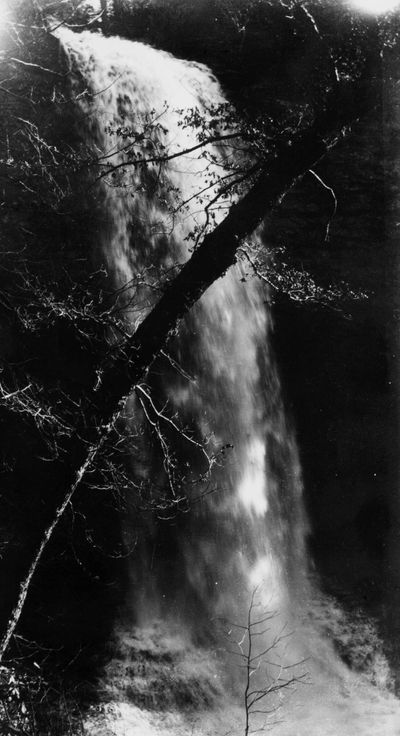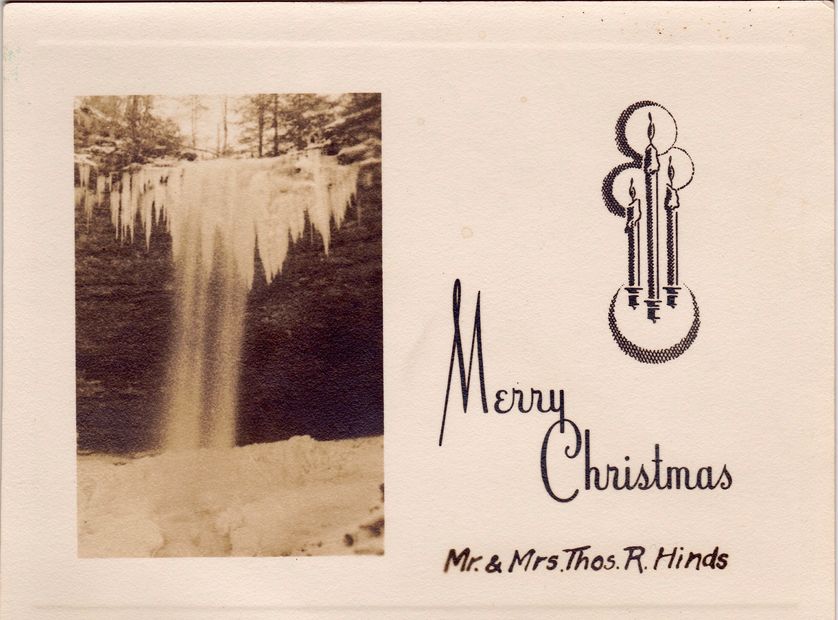Upper Piney Falls
This cabinet card photograph of Upper Piney Falls is one of several photos produced by George W. Morgan for his series, "Views of Harriman and Vicinity." By his own statements, Morgan arrived in Harriman in 1890, and appears in the 1892 Harriman City Directory. It is believed the photo dates to the early 1890s.

Contemporaneous with Mr. Morgan's photo above is this near identical view taken by Miss Harriet Russel Stratton who, at the time, was the area's most prolific photographer. The photo was printed directly from Miss Stratton's glass negative..

This rare photo of Upper Piney Falls was taken from a position more directly in front of the falls. It captures a view only possible during the winter months. The photo is from a post card dated April 14, 1914, making it the earliest known example a photo taken from this perspective.

For over a century, a favorite location for photographing Upper Piney Falls has been the hillside to the left of the falls. This view, taken circa 1885 by Miss Harriet Russell Stratton, is believed to be the first photograph taken of Upper Piney Falls.

Another view from the left hillside -- from a post card printed between 1910 and 1915.

Another "hillside photo" taken by Harriett Russell Stratton and printed from her glass negative. In this case, the negative is in the larger format - 9' x 5". The photo likely dates between 1890 and 1900.

During extended periods of sub-freezing temperatures, Upper Piney Falls "freezes over." This phenomenon has provided a popular photo opportunity for more than a century, The last professional photographs of the frozen falls were made during the winter of 1977. Although the negative of the photo shown here has not survived, the print it produced is identical in size to photos produced from the larger glass negative format. That being the case, it likely dates to between 1890 and 1900, and is almost certainly the first photo of Upper Piney Falls in a frozen state.

Holiday Greetings

A photo of the frozen Upper Piney Falls incorporated into a holiday card mailed out by Mr. & Mrs. Thomas Robert Hinds. Mr. Hinds was a graduate of the Grand View Normal Institute in 1903. It is believed the card was printed and mailed in the 1940s or 1950s.
The Ice Mound

During past instances when Upper Piney Falls has frozen, very few photos include the resulting ice mound at the base of the falls. This photo is the only one of its kind known to exist. The human subjects provide perspective on the size of the mound. The date of the photo is unknown, but it was likely taken between 1930 and 1945.
Illustrated Post Cards of Upper Piney Falls - Circa 1910





Lower Piney Falls
Lower Pine Falls is located one-third of a mile downstream (as the creek flows) from Upper Piney Falls. Its height is 40 feet in contrast to the 90-foot height of Upper Piney Falls. While the trails in the Piney Falls Natural Area can take you to the top of Lower Piney Falls, visiting the bottom of the falls is a daunting task. Consequently, early photos of Lower Piney Falls are rare. This photo of Lower Piney Falls is from a post card postmarked September 21, 1912.

To access the base of Lower Piney Falls, one must travel some distance downward toward the creek along the edges of the Little Piney Creek escarpment. Once reaching the creek, reverse course and move up the creek toward the falls.. Taken from an unused post card, this photo provides the view seen as one travels back toward the falls. The post card dates between 1900 and 1910.

This scene, photographed by Harriet Russell Stratton and printed from her original glass negative, is the earliest known photo of Lower Piney Falls. Being a time-lapse photograph, it reveals her skill as a photographer.. Likely taken between 1890 and 1900 (large glass negative format), it was an impressive effort by Miss Stratton. To obtain her photo, Miss Stratton traveled down steep terrain through old-growth forest to the base of the falls. She would have carried with her a large-box field camera, a tripod and 9" x 5" glass plates.

"Hell Hole"
As they became familiar with their surroundings, early residents of the area quickly began referring to a deep gorge on Edwards Branch (near Piney Falls) as, "Hell Hole." Well into the 20th Century, grown men would not enter Hell Hole alone for fear of not being able to find their way out. Sometime before 1900, Miss Harriett Stratton did not succumb to that fear. With her photographic arsenal described above, she ventured into the deep gorge and photographed this scene. Again, it is likely a first-of-its-kind photo.

Final Words
On Sunday, August 25, 1940, the Chattanooga Times published a "Celebration Edition" of its Sunday newspaper. A special section of the paper described and promoted the "The Tennessee Valley Celebration," occurring from Friday, August 30 through Monday, September 2. Included were photos of the many waterfalls and lakes in the area, with a few lines of poetry accompanying each. This photo of Upper Piney Falls appeared in that special section, and the poem appearing alongside the photo is reproduced below. Contrary to the poems wording, Piney Creek does not flow through Hell Hole. Hell Hole is located on Edwards Branch, which flows into Soak Creek and meets up with Little Piney Creek below the Upper and Lower Piney Falls.

